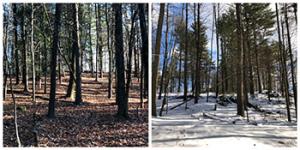Saint Anselm community members will notice some big changes to the campus woods this semester.
Over the last several months, thousands of trees have been removed from areas of the forest that have become overcrowded. The work is being done on 23 acres of land that is owned by the monastery as well as 30 acres of land owned by the college -- all located west of the power lines.
This effort is intended to create a healthier habitat for the trees and wildlife that live there, according to Brother Andrew Thornton, O.S.B.
Br. Andrew, who initiated the Saint Anselm College Forestry Project, has observed the forest over the years and first noticed trouble 20 years ago.
The rehabilitation of the forest is essential because of the ecological benefits, said Br. Andrew. “I began to see that our woods are choking themselves out,” he said.
When trees have to compete with each other for sunlight, that impedes their healthy growth. Many of the trees are aging, injured or reaching the end of their lifespan.
“A lot of the trees are not growing properly, or they have split trunks. Or they don’t get any sunlight so they grow spindly,” said Br. Andrew.

The new timber-management program involves commercial thinning and other cutting techniques to reduce crowding. Some of the variety of trees that were removed include white pine, oak and hemlock.
Br. Andrew said opening up the woods will allow new, healthier growth while reducing tree mortality. This will also promote a more varied wildlife habitat as birds and other predators will be attracted to the area.
“When Benedictines own land, they steward it,” he said. “They are very careful about changing anything hastily, and if they do change it, it’s supposed to be for the benefit of generations to come. We want to be very responsible, not only to the developed campus, but also the undeveloped campus. It’s what makes the place beautiful, isn’t it? We’re one of the last remaining pieces of countryside around here.”
The forestry plan was approved by the College's Board of Trustees, the Saint Anselm Abbey Corporation as well as by the Saint Anselm College Corporation.
None of the tree work can be seen from the main college campus.
The whole project is under the oversight of licensed forester Bob Burke, who operates Log Pro Inc. based out of Vermont. He marked the trees to be cut, sketched out the log yard and skidder paths, and supervised the cutting operation.
An estimated 5,500 trees have been harvested so far which includes the main canopy as well as some smaller trees that were removed incidental to the project’s overall intentions.
Over 60 truckloads of logs have already been taken away.
Most of the proceeds from the sale of lumber, logs, and chips will be used to cover the cost of the logging operation, the fee of the forester, and the timber tax. There may be some income generated from the project but that would be small, Br. Andrew said.
The area has only looked like the forest we see today for about 100 years. The land was mostly pastures and had hardly a single tree on it when the monks took over in 1889, according to Br. Andrew. The forest grew because the land was abandoned.
Br. Andrew cautioned that new trees won’t be visible in these woods for a while, however.
“It’s going to take a long time. You won’t see the fruit of this for 50-100 years,” he said.
The Saint Anselm College Forestry Project is expected to wrap up in early spring.
